What If? (5 page)
Authors: Randall Munroe

Laser Pointer
Q.
If every person on Earth aimed a laser pointer at the Moon at the same time, would it change color?
—Peter Lipowicz
A.
Not if we used
regular laser pointers.
Th
e first thing to consider is that not everyone can see the Moon at once. We could gather everyone in one spot, but let’s just pick a time when the Moon is visible to as many people as possible. Since
about 75 percent of the world’s population lives between 0°E and 120°E, we should try this while the Moon is somewhere over the Arabian Sea.
We could try to illuminate either a new moon or a full moon.
Th
e new moon is darker, making it easier to see our lasers. But the new moon is a trickier target, because it’s mostly visible during the day
—
washing out the effect.
Let’s pick a quarter
moon, so we can compare the effect of our lasers on the dark and light sides.

Here’s our target.
Th
e typical red laser pointer is about 5 milliwatts, and a good one would have a tight enough beam to hit the Moon
—
though it’d be spread out over a large fraction of the surface when it got there.
Th
e atmosphere would distort the beam a bit, and absorb some of it, but most of the light would make it.
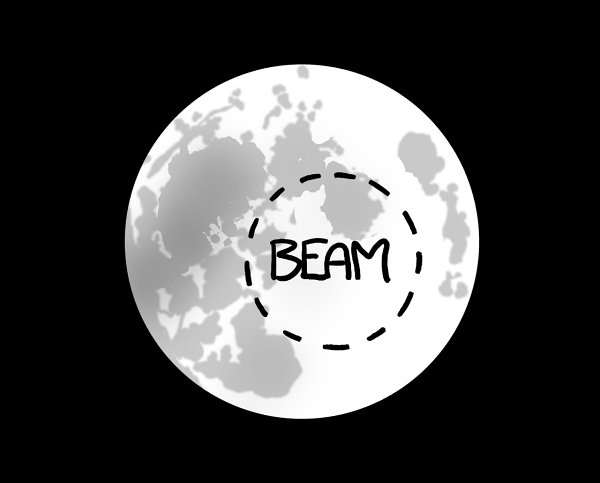
Let’s assume everyone has steady enough aim to hit the Moon, but no more than that, and the light spreads evenly across the surface.
Half an hour after midnight (
GMT
), everyone aims and presses the button.
Th
is is what happened:
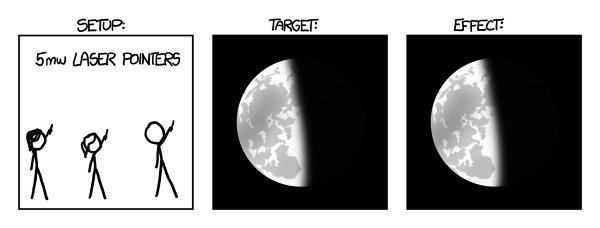
Well, that’s disappointing.
It makes sense, though. Sunlight bathes the Moon in a bit over a kilowatt of energy per square meter. Since the Moon’s cross-sectional area is around 10
13
square meters, it’s bathed in about 10
16
watts of sunlight
—
10 petawatts, or 2 megawatts per person
—
far outshining our 5-milliwatt laser pointers.
Th
ere are varying efficiencies in each part of
this system, but none of it changes that basic equation.

A 1-watt laser is an extremely dangerous thing. It’s not just powerful enough to blind you
—
it’s capable of burning skin and setting things on fire. Obviously, they’re not legal for consumer purchase in the US.
Just kidding! You can pick one up for $300. Just do a search for “1-watt handheld laser.”
So, suppose we spend the $2 trillion to buy 1-watt green lasers for everyone.
(Memo to presidential candidates:
Th
is policy would win my vote.) In addition to being more powerful, green laser light is nearer to the middle of the visible spectrum, so the eye is more sensitive to it and it seems brighter.
Here’s the effect:
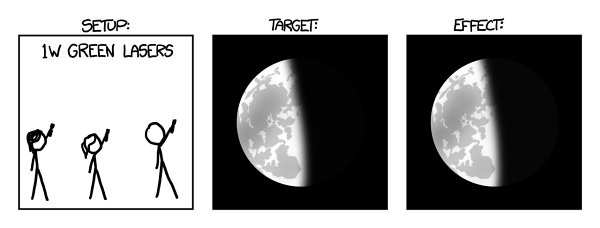
Dang.
Th
e laser pointers we’re using put out about 150 lumens of light (more than most flashlights) in a beam 5 arc-minutes wide.
Th
is lights up the surface of the Moon with about half a lux of illumination
—
compared to about 130,000 lux from the sun. (Even if we aimed them all perfectly, it would result in only half a dozen lux over about 10 percent of the Moon’s face.)
By comparison, the full moon lights up the Earth’s surface with about 1 lux of illumination
—
which means that not only would our lasers be too weak to see from Earth, but if you were standing on the Moon, the laser light on the landscape would be fainter than moonlight is to us on Earth.

With advances in lithium batteries and LED technology over the last ten years, the high-performance flashlight market has exploded. But it’s clear that flashlights aren’t gonna cut it. So let’s skip past all of that and give everyone a Nightsun.
You may not recognize the name, but chances are you’ve seen one in operation: It’s the searchlight mounted on police and Coast Guard
helicopters. With an output on the order of 50,000 lumens, it’s capable of turning a patch of ground from night to day.
Th
e beam is several degrees wide, so we would want some focusing lenses to get it down to the half-degree needed to hit the Moon.
Here’s the effect:

It’s hard to see, but we’re making progress!
Th
e beam is providing 20 lux of illumination, outshining the ambient light on the night half by a factor of two! However, it’s quite hard to see, and it certainly hasn’t affected the light half.
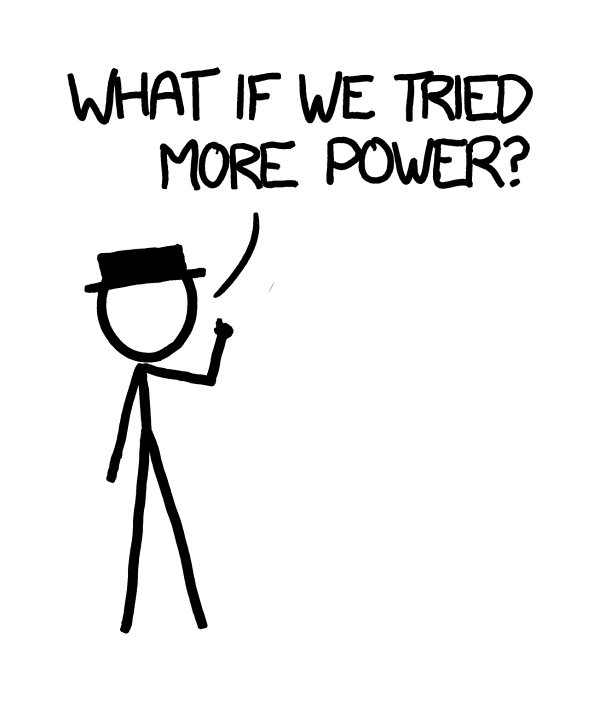
Let’s swap out each Nightsun for an IMAX projector array
—
a 30,000-watt pair of water-cooled lamps with a combined output of over a million lumens.
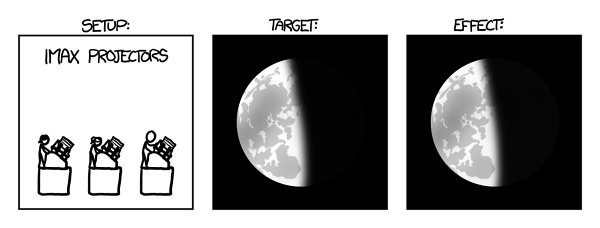
Still barely visible.
At the top of the Luxor Hotel in Las Vegas is the most powerful spotlight on Earth. Let’s give one of them to everyone.
Oh, and let’s add a lens array to each so the entire beam is focused on the Moon:
